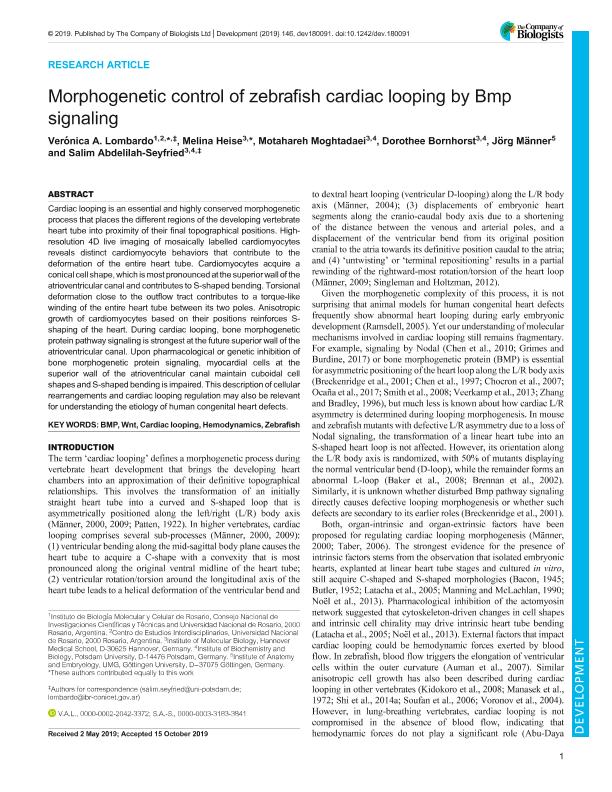Artículo
Morphogenetic control of zebrafish cardiac looping by Bmp signaling
Lombardo, Veronica Andrea ; Heise, Melina; Moghtadaei, Motahareh; Bornhorst, Dorothee; Männer, Jörg; Abdelilah Seyfried, Salim
; Heise, Melina; Moghtadaei, Motahareh; Bornhorst, Dorothee; Männer, Jörg; Abdelilah Seyfried, Salim
 ; Heise, Melina; Moghtadaei, Motahareh; Bornhorst, Dorothee; Männer, Jörg; Abdelilah Seyfried, Salim
; Heise, Melina; Moghtadaei, Motahareh; Bornhorst, Dorothee; Männer, Jörg; Abdelilah Seyfried, Salim
Fecha de publicación:
11/2019
Editorial:
Company of Biologists
Revista:
Development
ISSN:
0950-1991
Idioma:
Inglés
Tipo de recurso:
Artículo publicado
Clasificación temática:
Resumen
Cardiac looping is an essential and highly conserved morphogenetic process that places the different regions of the developing vertebrate heart tube into proximity of their final topographical positions. Highresolution 4D live imaging of mosaically labelled cardiomyocytes reveals distinct cardiomyocyte behaviors that contribute to the deformation of the entire heart tube. Cardiomyocytes acquire a conical cell shape, which is most pronounced at the superior wall of the atrioventricular canal and contributes to S-shaped bending. Torsional deformation close to the outflow tract contributes to a torque-like winding of the entire heart tube between its two poles. Anisotropic growth of cardiomyocytes based on their positions reinforces Sshaping of the heart. During cardiac looping, bone morphogenetic protein pathway signaling is strongest at the future superior wall of the atrioventricular canal. Upon pharmacological or genetic inhibition of bone morphogenetic protein signaling, myocardial cells at the superior wall of the atrioventricular canal maintain cuboidal cell shapes and S-shaped bending is impaired. This description of cellular rearrangements and cardiac looping regulation may also be relevant for understanding the etiology of human congenital heart defects.
Palabras clave:
BMP
,
CARDIAC LOOPING
,
HEMODYNAMICS
,
WNT
,
ZEBRAFISH
Archivos asociados
Licencia
Identificadores
Colecciones
Articulos(IBR)
Articulos de INST.DE BIOLOGIA MOLECULAR Y CELULAR DE ROSARIO
Articulos de INST.DE BIOLOGIA MOLECULAR Y CELULAR DE ROSARIO
Citación
Lombardo, Veronica Andrea; Heise, Melina; Moghtadaei, Motahareh; Bornhorst, Dorothee; Männer, Jörg; et al.; Morphogenetic control of zebrafish cardiac looping by Bmp signaling; Company of Biologists; Development; 146; 22; 11-2019; 1-13
Compartir
Altmétricas



